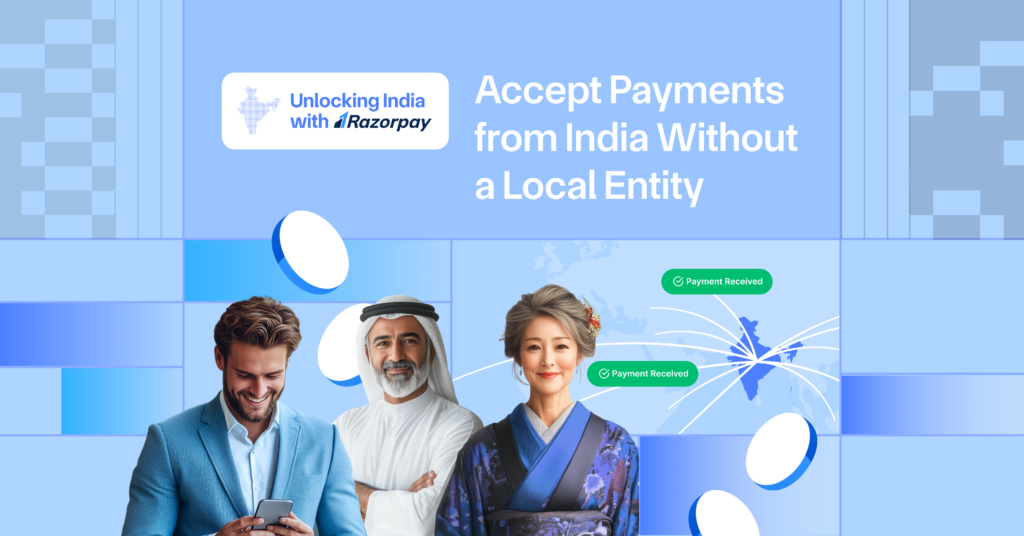Imagine a software developer in Bangalore subscribing to your SaaS platform, a fashion enthusiast in Mumbai purchasing your limited-edition sneakers, or a student in Chennai enrolling in your online course. India’s digital economy is booming, creating unprecedented opportunities for global businesses to tap into a market of 1.4 billion potential customers.
Behind this growth is a rising middle class with increasing digital literacy and disposable income. These consumers are eager to access global products and services—whether it’s streaming international content, purchasing exclusive items unavailable locally, or booking travel experiences abroad. With India’s e-commerce market projected to reach $200 billion by 2026, the question isn’t whether to enter the Indian market, but how to do it effectively.
This guide will show you how to overcome payment challenges and seamlessly accept payments from Indian customers without establishing a local entity. We’ll explore India’s unique payment landscape, identify key challenges for international businesses, provide solutions for accepting payments, and demonstrate how Razorpay can help you unlock this high-growth market.
Regulatory Barriers: Why Foreign Entities Struggle to Accept Indian Payments
For international businesses, navigating India’s regulatory framework presents significant challenges.
The Reserve Bank of India (RBI) mandates that domestic payment processing must be done through entities regulated under the Payment and Settlement Systems Act. Until recently, this effectively meant foreign businesses needed to establish a local entity in India — a resource-intensive process involving company registration, local directors, tax registrations, and compliance with complex regulations.
Under the Foreign Exchange Management Act (FEMA) guidelines, cross-border transactions face additional scrutiny and restrictions. The RBI’s guidelines regulate how payment data is stored and processed, with stringent requirements for data localization.
These regulatory requirements can be a challenge for global businesses wanting to serve Indian customers.
Understanding India’s Unique Digital Payment Landscape
India’s payment ecosystem differs dramatically from Western markets, where credit cards remain dominant.
The Dominance of UPI: India’s Revolutionary Payment System
UPI (Unified Payments Interface) has transformed how Indians pay for goods and services. According to the National Payments Corporation of India (NPCI), UPI processed 12.2 billion transactions worth ₹18.41 trillion (approximately $220 billion) in January 2024 alone.
This government-backed instant payment system now accounts for 80% of all digital transactions in India, making it essential for any business targeting Indian consumers.
RuPay’s Growing Importance in the Indian Market
RuPay, India’s domestic card network, has gained significant market share, now supported by over 750 million debit and credit cards. The recent launch of RuPay credit on UPI has further accelerated its growth, allowing UPI users to make credit card payments through the UPI interface.
Limited Credit Card Penetration
Unlike Western markets, credit card penetration in India remains relatively low at around 6% of the population. This means that businesses relying solely on international credit card networks are missing out on the vast majority of Indian consumers.
Key Challenges for International Businesses Accepting Indian Payments
Limited Payment Options: Why Credit Cards Alone Won’t Work in India
International businesses often rely on payment processors that primarily support credit cards. However, this approach excludes the majority of Indian consumers who prefer UPI, domestic debit cards, and other local payment methods.
Transaction Failure Rates: Understanding OTP Requirements
India’s regulatory framework mandates Two-Factor Authentication (2FA) for online card transactions, usually through One-Time Passwords (OTPs). International payment processors that don’t natively support this authentication flow experience significantly higher decline rates.
Currency Conversion and Settlement Complications
International businesses face challenges with currency conversion and settlement when accepting Indian Rupee (INR) payments, including fluctuating exchange rates, settlement delays, higher processing fees, and complex reconciliation processes.
Essential Payment Methods to Offer Indian Customers
Implementing UPI Integration: The Must-Have Payment Option
With 500+ million active users, UPI is non-negotiable for businesses targeting Indian consumers. Supporting UPI enables instant, secure transactions, higher conversion rates, and access to customers across all income segments.
Supporting RuPay Cards to Maximize Market Reach
RuPay’s growing dominance makes it essential for international businesses to support this domestic card network, opening access to 750+ million cardholders and improving transaction success rates.
Adding Traditional Payment Methods
While UPI dominates, a comprehensive approach should still include international and domestic credit cards, debit cards with proper OTP authentication, and net banking options across major Indian banks.
Step-by-Step Guide to Accept INR Payments Without an Indian Entity
Cross-Border Payment Processing Options
Modern payment solutions now enable foreign entities to accept payments from Indian customers without establishing a local entity through a partnership with an authorized Indian Payment Aggregator, integration with platforms supporting local payment methods, and ensuring compliance through these partners.
Currency Conversion and Settlement Best Practices
When accepting INR payments and settling in your preferred currency, choose a provider with competitive exchange rates, ensure transparency in conversion fees, and optimize settlement frequency to minimize currency fluctuation risks.
Compliance Requirements for Foreign Businesses
Even without a local entity, foreign businesses must adhere to KYC requirements for high-value transactions, GST regulations for digital services, and data privacy compliance under India’s evolving regulatory framework.
How Razorpay’s Import Stack Solves These Challenges
Razorpay’s Import Stack enables international businesses to seamlessly accept INR payments without a local entity, addressing all the key challenges faced by global merchants.
Seamless UPI and RuPay Integration for International Businesses
Razorpay provides India’s best UPI stack with support for standard UPI payments, RuPay cards, and industry-leading success rates through an in-house UPI switch.
Comprehensive Subscription Solutions
One of Razorpay’s standout features is its robust support for subscription-based businesses. The platform offers:
- UPI Autopay for recurring payments—a game-changer for subscription services
- Flexible billing cycles to accommodate various business models
- Intelligent retry logic for failed payments to reduce churn
- Subscription analytics and insights to optimize retention
- EMI options for higher-value subscriptions, increasing conversion rates
- Automatic invoice generation for subscribers
These subscription capabilities make Razorpay particularly valuable for SaaS companies, digital content providers, and membership-based services looking to expand into the Indian market.
Multi-Currency Settlement Options for Foreign Bank Accounts
With Razorpay, businesses can accept payments in INR from Indian customers and settle funds in their preferred currency (USD, EUR, GBP, etc.) directly into overseas bank accounts while maintaining compliance with all regulatory requirements.
Improving Transaction Success Rates with Localized Authentication
Razorpay addresses transaction failure challenges through native OTP authentication for card payments, an in-house acquiring switch for higher success rates, 99.99% uptime with capacity for 10,000+ transactions per second, and sub-100ms latency for faster payment processing.
Conclusion: Unlocking India’s Massive E-commerce Market
India represents one of the world’s most significant growth opportunities for global businesses. The country’s unique payment landscape, dominated by UPI and RuPay, requires a specialized approach to payment acceptance.
By implementing the right payment solution that supports local payment methods and addresses regulatory requirements, international businesses can tap into a market of 1.4 billion potential customers, reduce cart abandonment rates, increase conversion rates, and operate compliantly without establishing a local entity.
With solutions like Razorpay’s Import Stack, the barriers to entering the Indian market have been significantly reduced, making it easier than ever for global businesses to unlock the potential of the world’s fastest-growing digital economy.



